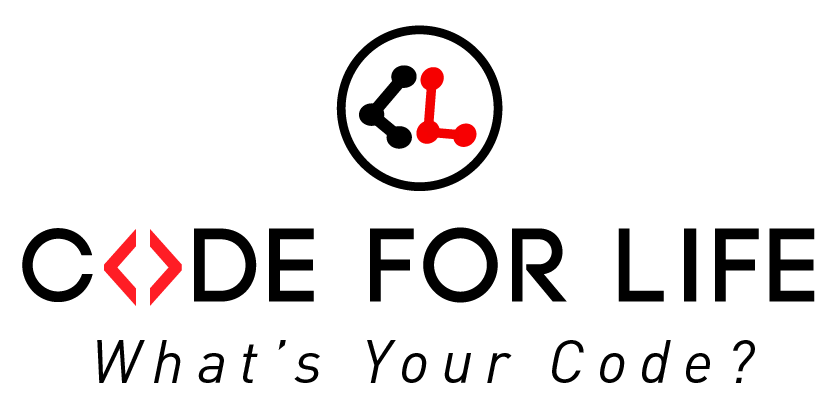What We Do
Over 40 Years of Teaching
Equipping The Next Generation of Creators & Makers!
CODE FOR LIFE is an exciting new collaborative initiative that unites Nyack College, Praxis Connections, the tech community, and local church partners. CODE FOR LIFE combines the proximity of (and therefore ease of access to) neighborhood churches, the resources of Nyack College’s math and science departments, and the expertise of technology professionals to bring practical tools for professional and economic success to kids living in high poverty neighborhoods. CODE FOR LIFE employs
By participating in CODE FOR LIFE, young people in high-poverty neighborhoods can develop practical life skills and the


The Problem:
A Tech-Driven Economy Requires Skill-Building
Our labor market is becoming increasingly more digital, data-driven and automated. We are now in a race between how quickly we are able to equip the workforce for our accelerating tech-driven economy. This shift significantly reduces the number of well-paying unskilled jobs associated with the economy of the past. Those living in under-resourced communities lacking access to skill development opportunities are at the greatest risk of being left behind. However, our city and nation can ill-afford to leave its young people out of the tech-driven economy. To remain competitive, the economy of the future requires a diverse and highly-skilled workforce.
tech jobs in NYC
%
STEM Workers earn 40% more than non-stem
%
STEM Sector contributes 12.3% of City tax Revenue
Since 1990 the U.S. labor market has experienced a 79% increase (9.7 million to 17.3 million) in employment related to science, technology, engineering and math (STEM) occupations. Computer jobs alone have increased by 338% over the same period. In fact, New York City’s competitive advantage is largely tied to growth in STEM fields – the tech ecosystem added 45,000 jobs between 2003 and 2013, outperforming the overall rate of employment growth in the City and the nation. Further, the New York City tech ecosystem includes 291,000 jobs that facilitate, produce, or are enabled by technology. Despite this growth, challenges remain in how to expand these opportunities to those living in under-resourced communities.
Opportunities in the STEM sector provide new pathways for success. Typical workers in the STEM field earn significantly more, on average, when compared to typical non-STEM workers. The median earnings for STEM workers 25 and older were $71,000 in 2016, yet non-STEM workers earned approximately $43,000, 40% less than their STEM counterparts.
With the erosion of the manufacturing industry, the STEM sector provides career opportunities that do not require a post-secondary degree as an entry ticket to earning a higher income. For example, computer tech support and website development roles do not require a bachelor’s degree, yet provide an annual median wage of approximately $63,000 and $66,000 respectively. In fact, a report commissioned by the Associate for a Better New York, Citi, Google, and the NY Tech Meetup, found 44% of the City’s 291,000 tech jobs do not require a bachelor’s degree and offer hourly pay rates that are 49% above the City average.
Additionally, growth in the tech ecosystem provides a measurable value-add to the City’s economy – approximately 7% of the City’s workforce is employed directly in the technology sector producing 12.3% of the tax revenue ($5.6 billion) to the City.
Tech Sector Demographics
%
White
%
Asian
%
African American
%
Hispanic
Overall, the New York City workforce is 44% white, 23% black or African American, 28% Latina/o and 15% Asian. However, in 2015 the STEM workforce was 69% white, only 6.5% black or African American, 6.7% Latina/o or Hispanic, and 16.6% Asian. The STEM workforce represents companies such as Google, Facebook, and Thompson Reuters that consider New York its home. These companies will need a steady flow of talent to remain competitive. Therefore, we will need to draw from the talent of all of NYC and develop a diverse and well-prepared cadre of emerging professionals to keep pace with the speed and breadth of our tech-enabled economy.
Code for Life Theory and Methodology of Change
Code for Life employs a theory and methodology of change that transforms the way young people view themselves and their future by equipping them with the life and tech skills needed to thrive in our new digital and data-driven economy. Code for Life is built on the following four-part framework: Neighborhood Focused, Blended Youth & Tech Development, Collective/Collaborative Approach, and Outcomes-Measurement Disciplined.

CHOOSE US
Why Learn With Us?
Neighborhood Focused
Curabitur non nulla sit amet nisl tempus convallis quis ac lectus.
Over 10,000 Graduates
Curabitur non nulla sit amet nisl tempus convallis quis ac lectus.
Located in the Heart of San Francisco
Curabitur non nulla sit amet nisl tempus convallis quis ac lectus.
World Class Educators
Curabitur non nulla sit amet nisl tempus convallis quis ac lectus.

TESTIMONIALS
What Our Students Say

Cras ultricies ligula sed magna dictum porta. Curabitur aliquet quam id dui posuere blandit. Donec rutrum congue leo eget malesuada. Vivamus suscipit tortor eget felis porttitor volutpat. Quisque velit nisi, pretium ut lacinia in, elementum id enim.

Jane Doe
Learning Japanese for Business

Cras ultricies ligula sed magna dictum porta. Curabitur aliquet quam id dui posuere blandit. Donec rutrum congue leo eget malesuada. Vivamus suscipit tortor eget felis porttitor volutpat. Quisque velit nisi, pretium ut lacinia in, elementum id enim.

Arnold Smith
Full-time Student Abroad
Book A Course Today!
Vivamus magna justo, lacinia eget consectetur sed, convallis at tellus. Donec rutrum congue leo eget malesuada. Donec rutrum congue leo eget malesuada. Quisque velit nisi, pretium ut lacinia in, elementum id enim. Vivamus magna justo, lacinia eget consectetur sed.
